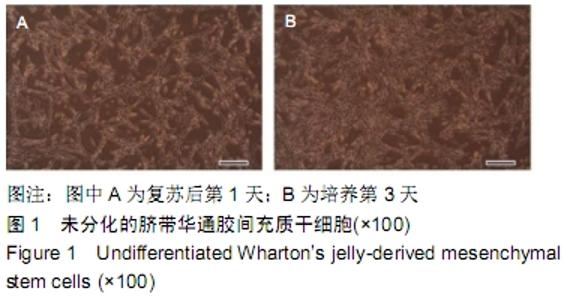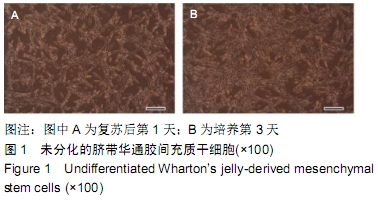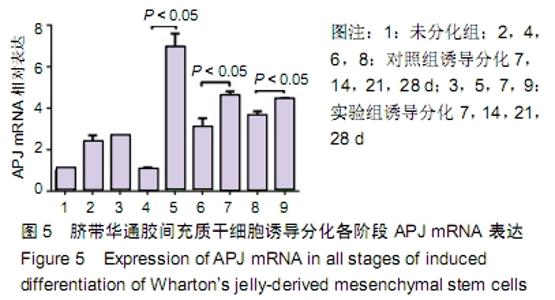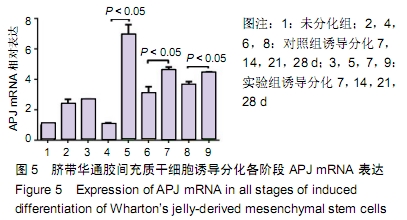[1] GAO LR, ZHANG NK, BAI J, et al. The apelin-APJ pathway exists in cardiomyogenic cells derived from mesenchymal stem cells in vitro and in vivo. Cell Transplant. 2010;19(8):949-958.
[2] GAO LR, XU RY, ZHANG NK, et al. Increased apelin following bone marrow mononuclear cell transplantation contributes to the improvement of cardiac function in patients with severe heart failure. Cell Transplant. 2009;18(12):1311-1318.
[3] 徐小红,王力,张宁坤, 等.Apelin-13对5-aza诱导脐带间充质干细胞向心肌细胞分化的影响[J].解放军医学杂志, 2013,38(10):796-800.
[4] 程涛,陈宇,张宁坤,等.Apelin13对人胚胎干细胞定向心肌细胞分化效率的影响[J].山东医药,2017,57(33):1-4.
[5] CHNG SC, HO L, TIAN J, et al. ELABELA: a hormone essential for heart development signals via the apelin receptor. Dev Cell. 2013;27(6):672-680.
[6] HO L, TAN SY, WEE S, et al. ELABELA Is an Endogenous Growth Factor that Sustains hESC Self-Renewal via the PI3K/AKT Pathway. Cell Stem Cell. 2015;17(4):435-447.
[7] KUBA K, SATO T, IMAI Y, et al. Apelin and Elabela/Toddler; double ligands for APJ/Apelin receptor in heart development, physiology, and pathology. Peptides. 2019;111:62-70.
[8] WANG Z, YU D, WANG M, et al. Elabela-apelin receptor signaling pathway is functional in mammalian systems. Sci Rep. 2015;5: 8170.
[9] SATO T, SATO C, KADOWAKI A, et al. ELABELA-APJ axis protects from pressure overload heart failure and angiotensin II-induced cardiac damage. Cardiovasc Res. 2017;113(7): 760-769.
[10] GAO LR, ZHANG NK, ZHANG Y, et al. Overexpression of apelin in Wharton' jelly mesenchymal stem cell reverses insulin resistance and promotes pancreatic β cell proliferation in type 2 diabetic rats. Stem Cell Res Ther. 2019;10(1):6.
[11] QIAN Q, QIAN H, ZHANG X, et al. 5-Azacytidine induces cardiac differentiation of human umbilical cord-derived mesenchymal stem cells by activating extracellular regulated kinase. Stem Cells Dev. 2012;21(1):67-75.
[12] SORGEN PL, TREASE AJ, SPAGNOL G, et al. Protein⁻Protein Interactions with Connexin 43: Regulation and Function. Int J Mol Sci. 2018;19(5).: E1428.
[13] WILDI K, REICHLIN T, TWERENBOLD R, et al. Serial changes in high-sensitivity cardiac troponin I in the early diagnosis of acute myocardial infarction. Int J Cardiol. 2013;168(4):4103-4110.
[14] DELMAR M, MAKITA N. Cardiac connexins, mutations and arrhythmias. Curr Opin Cardiol. 2012;27(3):236-241.
[15] THIMM J, MECHLER A, LIN H, et al. Calcium-dependent open/closed conformations and interfacial energy maps of reconstituted hemichannels. J Biol Chem. 2005;280(11): 10646-10654.
[16] ANTUNES E, BORRECHO G, OLIVEIRA P, et al. Immunohistochemical evaluation of cardiac connexin43 in rats exposed to low-frequency noise. Int J Clin Exp Pathol. 2013;6(9): 1874-1879.
[17] ADAMCOVA M, POPELOVA-LENCOVA O, JIRKOVSKY E, et al. Cardiac troponins-Translational biomarkers in cardiology: Theory and practice of cardiac troponin high-sensitivity assays. Biofactors. 2016;42(2):133-148.
[18] JIRKOVSKÝ E, LENČOVÁ-POPELOVÁ O, HROCH M, et al. Early and delayed cardioprotective intervention with dexrazoxane each show different potential for prevention of chronic anthracycline cardiotoxicity in rabbits. Toxicology. 2013;311(3): 191-204.
[19] PRADHAN L, GOPAL S, LI S, et al. Intermolecular Interactions of Cardiac Transcription Factors NKX2.5 and TBX5. Biochemistry. 2016;55(12):1702-1710.
[20] OLSON EN. Gene regulatory networks in the evolution and development of the heart. Science. 2006;313(5795):1922-1927.
[21] LI L, LI L, XIE F, et al. Jagged-1/Notch3 signaling transduction pathway is involved in apelin-13-induced vascular smooth muscle cells proliferation. Acta Biochim Biophys Sin (Shanghai). 2013; 45(10):875-881.
[22] XIE F, LIU W, FENG F, et al. Apelin-13 promotes cardiomyocyte hypertrophy via PI3K-Akt-ERK1/2-p70S6K and PI3K-induced autophagy. Acta Biochim Biophys Sin (Shanghai). 2015;47(12): 969-980.
[23] LIU MQ, CHEN Z, CHEN LX. Endoplasmic reticulum stress: a novel mechanism and therapeutic target for cardiovascular diseases. Acta Pharmacol Sin. 2016;37(4):425-443.
[24] ZHOU Q, CHEN L, TANG M, et al. Apelin/APJ system: A novel promising target for anti-aging intervention. Clin Chim Acta. 2018;487:233-240.
[25] ASHLEY EA, POWERS J, CHEN M, et al. The endogenous peptide apelin potently improves cardiac contractility and reduces cardiac loading in vivo. Cardiovasc Res. 2005;65(1):73-82.
[26] KIM J. Apelin-APJ signaling: a potential therapeutic target for pulmonary arterial hypertension. Mol Cells. 2014;37(3):196-201.
[27] WU L, CHEN L, LI L. Apelin/APJ system: A novel promising therapy target for pathological angiogenesis. Clin Chim Acta. 2017;466:78-84.
[28] ZHOU Q, CAO J, CHEN L. Apelin/APJ system: A novel therapeutic target for oxidative stress-related inflammatory diseases (Review). Int J Mol Med. 2016;37(5):1159-1169.
[29] LU L, WU D, LI L, et al. Apelin/APJ system: A bifunctional target for cardiac hypertrophy. Int J Cardiol. 2017;230:164-170.
[30] AYDIN S, KULOGLU T, AYDIN Y, et al. Effects of iloprost and sildenafil treatment on elabela, apelin-13, nitric oxide, and total antioxidant and total oxidant status in experimental enzyme-positive acute coronary syndrome in rats. Biotech Histochem. 2019:1-7.
[31] COQUEREL D, CHAGNON F, SAINSILY X, et al. ELABELA Improves Cardio-Renal Outcome in Fatal Experimental Septic Shock. Crit Care Med. 2017;45(11):e1139-e1148.
|











